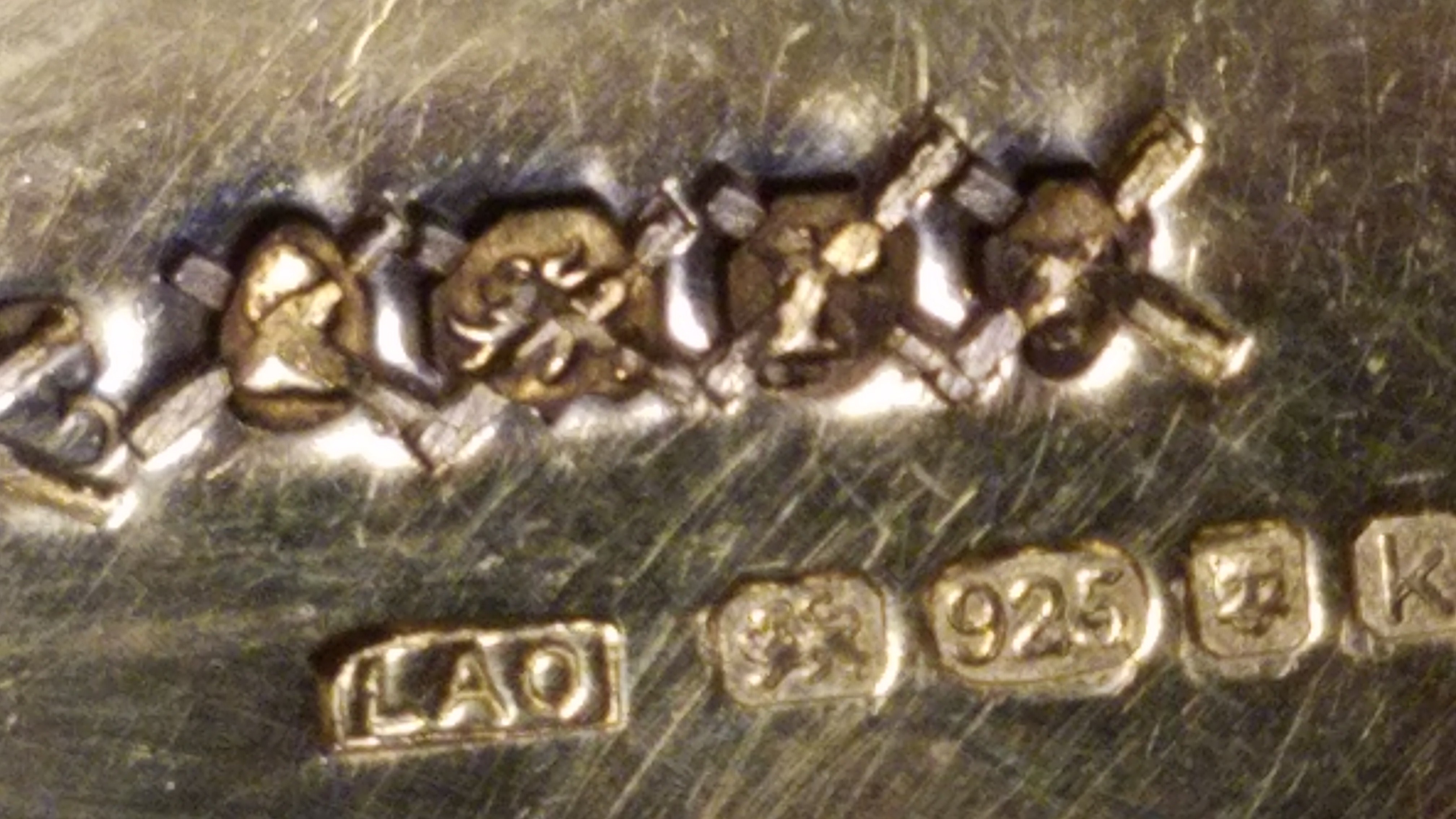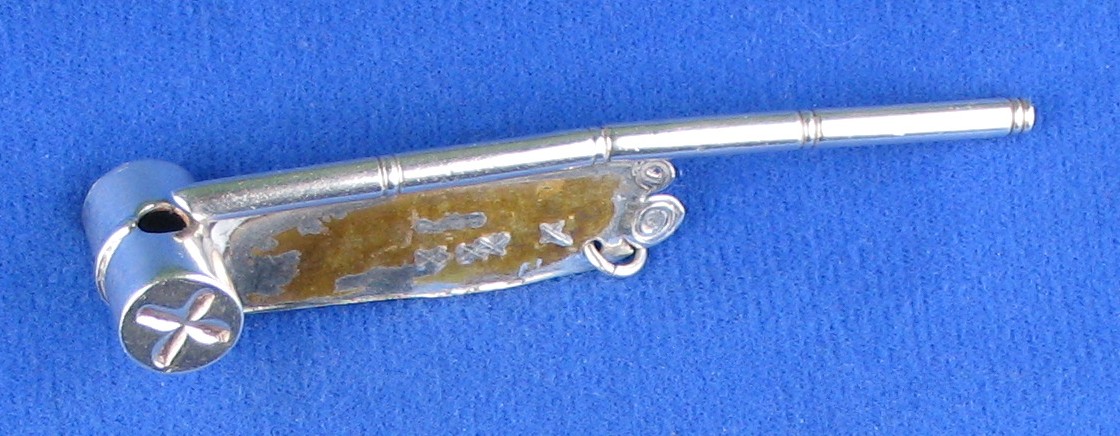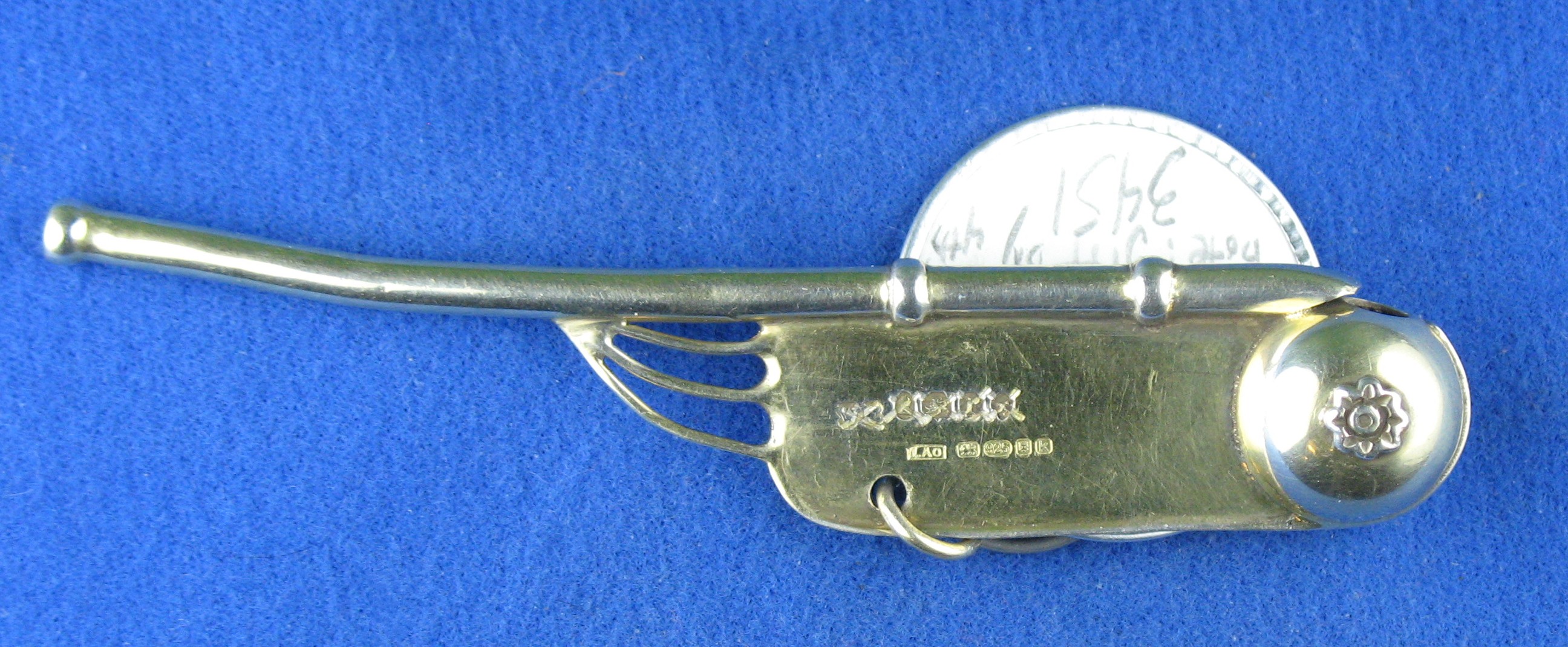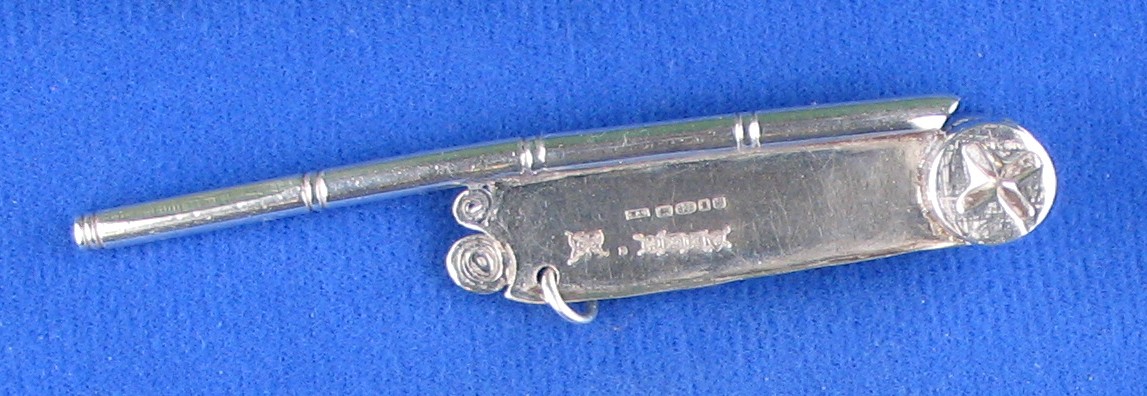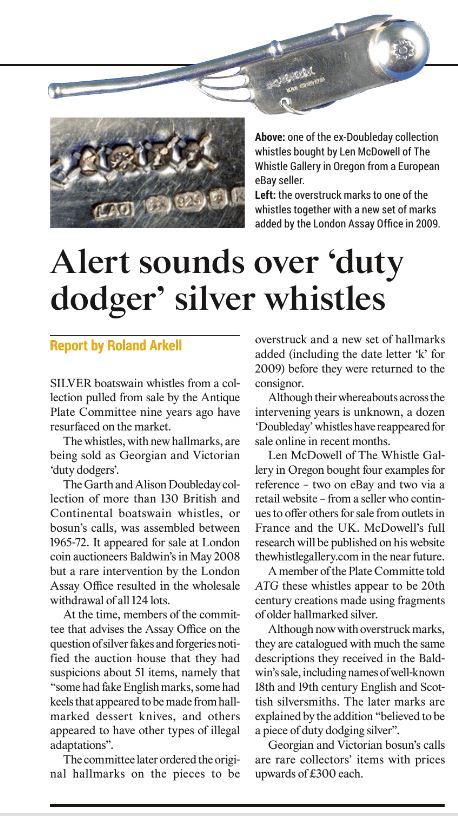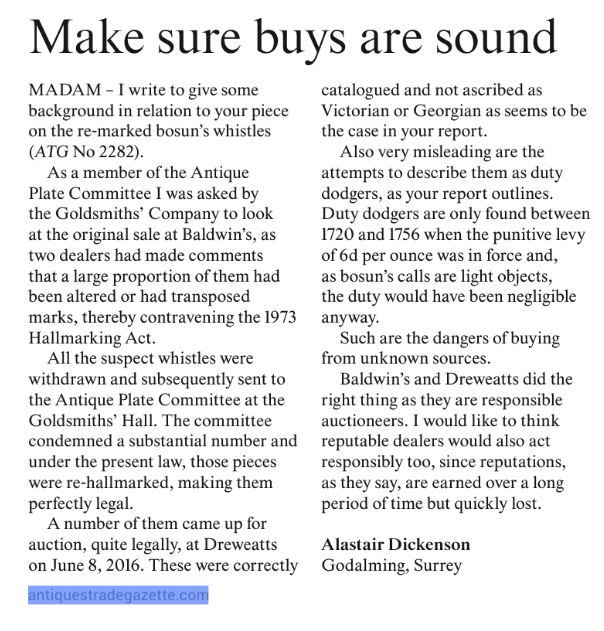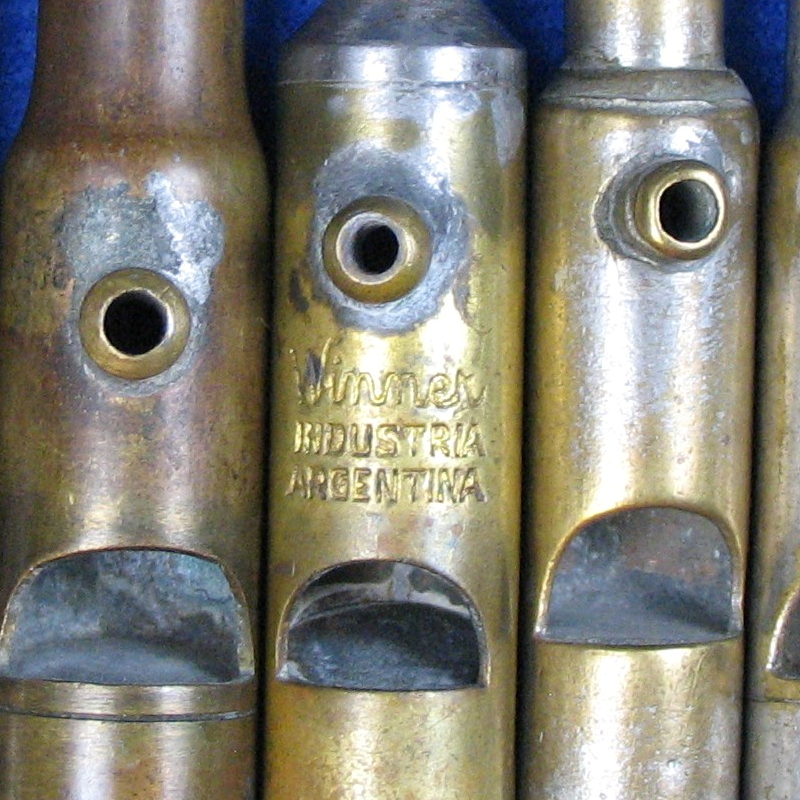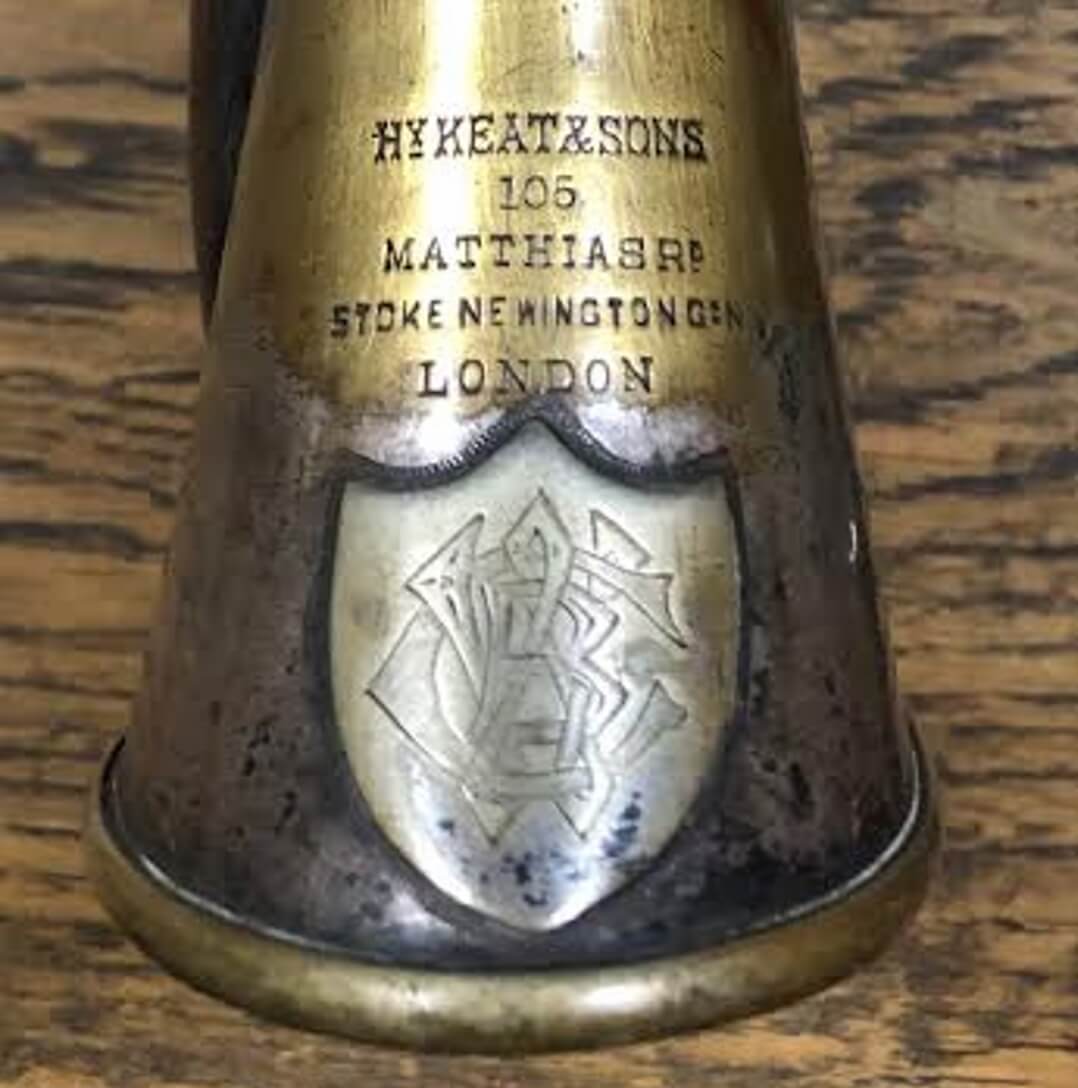Recently boatswain whistles have come into the limelight. Hallmarked and dated, but with large Xed out stamps — new smaller ones stamped above or below the old hallmarks.So we find whistles seen from a very specific 2008 auction listing. Here is a close-up example:
Where did they come from ?? What do the old hallmarks reveal ??
What do the new stamps reveal ??
The Garth Doubleday collection was reputably gathered from 1965 to 1972. 124 plus rare boatswain whistles from 12 countries were to go up for auction on May 8th 2008 at Baldwin’s coin auctioneers in London. ( we counted 136 whistles ).
For various reasons given in the attached article from Antiques Trade Gazette (Excerpt and link to article will be provided in this Spotlight.), the whistles were pulled from auction at the 11th hour before auction at the advice of the London Assay Office, represented by an independent dealer and two Antique Plate Committee members. Now in 2016 some of these very whistles have resurfaced, however they now have stamped out hallmarks.
These stamps ‘LAO’ ( London Assay Office ) have been presented as ‘Duty Dodger’ over stamps which would be from pre 1900s. As can be seen these exact same whistles did not have the over stamps in the 1960s/70s. Now they do. This because they proved to be questionable authenticity as judged by the LAO.
At first these appeared on eBay and by a seller who continues to have them for sale at his antique outlets in France and the UK under several names. For example from a set of six seen ( access number 3097 ) in the collection three have been sold to date. We purchased two for examination and two others through eBay. At least one is stamped as silver and has deteriorated plating, the plating quite eroded as shown.
Only whistles matched up from that collection have appeared, now with over stamps. All have been promoted and sold and their identification exactly matching the information from that auction catalog, this being done even though the hallmarks are mostly illegible.
When first asked where he retrieved these whistles from, the seller said he bought them from an estate sale, later he stated from a dealer in the UK.
What do we find so far ?? – Firstly, that the original whistles in question were being watched with suspicion and later stamped as fakes. However having been withdrawn and then having certain whistles surface under the pretense of ‘duty dodging’ would make them doubly so by all means. Which of the 50 plus whistles reportedly in question is not stated, but about one dozen have surfaced of this collection in such a manner.
The following link shows the Baldwin pictures and access numbers for research and comparison which is extensive: CLICK TO VIEW
For example, the whistle pictured above is #3119 from 1865.
Further examples are shown:
This is one from the set of six access number 3097 for 1832 William Elliot. Three have been seen for sale.
Number 3161 for 1815 maker GCC Edinburgh.
The numbers as follows are whistles sold on eBay, directly on the internet and two for sale currently on a French website
3803 – London 1800 maker MB ( Mark Buck )
3084 – Bateman 1801
3094 – Chawner 1828
3098 – Aldous 1835
3110 — AT 1862
3116 — Richards and Brown 1865
3118 – Atkins 1865 ( private sale )
3131 — Hilliard and Thomason 1877
The article reporting the sale and investigations from 2008
is reproduced courtesy of the Antique Trades Gazette.
Antiques Trade Gazette (VIEW ARTICLE HERE)
"Plate Committee Step in to Halt Sale of Silver Whistles"
A rare intervention by the London Assay Office has resulted in the wholesale withdrawal of a 124-lot collection of silver bosun’s calls scheduled to be sold in London last week.
- ATG Reporter Roland Arkell
- 12 May 2008
The calls, or whistles, which were due to be sold at London coin auctioneers Baldwin’s on May 7, were pulled just at the eleventh hour after the authenticity of some was called into question.
The collection was formed over 35 years ago by Garth Doubleday and includes British and Continental specimens. It appears that members of the Antique Plate Committee, the expert body of silver specialists that advises the Assay Office on the question of fakes and forgeries in antique British plate, were first contacted after someone who had seen the collection had doubts about the authenticity of certain items.
The week before the sale, two separate visits to the saleroom were made on May 1 and 2 by an independent dealer and two Antique Plate Committee members. On the basis of their advice the Assay Office notified the auction house that they had suspicions about a substantial proportion of the pieces.
According to the Assay Office, “there were several different reasons why the articles were believed to be suspect, namely that some had very suspicious fake English marks, Chinese marks, some had keels that appeared to be adapted from hallmarked dessert knives, and others appeared to have other types of illegal adaptations”.
They requested the whistles be withdrawn from the sale in their legal capacity as the watchdog for authenticity of hallmarking and quality control of precious metals and consumer protection.
Dr Robert Organ, deputy warden at the Assay Office, first contacted Baldwin's on Friday, 2 May and communicated with them all last week.
Shortly before the auction the Assay Office sent Baldwin’s a list of 51 of the whistles whose authenticity it was questioning and, in the light of this, Baldwin’s decided just before the sale to withdraw the entire collection.
Edward Baldwin, chairman of the auction house, said the next stage will be to submit the pieces to the Antique Plate Committee for scrutiny and assessment. The Committee meets four times a year at Goldsmiths’ Hall for the purposes of assessing items over which questions have been raised.
Mr Baldwin said that he hoped to be able to re-offer the whistles at a later date. “I will only offer the items that the Plate Committee approve”, he said but added that in his opinion this would be a substantial proportion of the collection.
He told ATG that at the pre-sale view there were different opinions as to which were right and which were wrong. He felt two issues had raised questions about the collection: that no-one had seen so many and that they were being sold by a coin specialist.
Early, pre-19th century, bosun’s calls are rare collectors’ items and in short supply. Baldwin’s do not normally sell antique silver smallware but their vendor was also a numismatist and Baldwin’s client.
Mr Doubleday formed the collection between 1965 and 1972, buying the whistles through various members of the silver trade but also, according to the auction catalogue, using the services of an antique dealer whom he described as “a knowledgeable elderly antiquarian who haunted the antiques shops in the Lanes of Brighton, the London Silver Vaults and other likely sources, where he snapped up all the calls on offer”.
To close here are a couple close up stamps:
THE GARTH AND ALISON COLLECTION
OF BOSUN’S CALLS – 1965-1972.
Maritime Museums at Chatham and Tenby
12 countries in addition to Great Britain
Garth Doubleday ( brother Gordon )
126 different access numbers
136 bosons with 1 set of 6, 1 set of four, two sets of two
An independent researcher comments on over stamps:
You know, I don't think a single Bosun Call was found to be a tax dodger and so marked as one in the 18th and 19th centuries, and here is why.
Bosun calls generally weighted 25 grams or less. A Call weighting 25 grams would have a little over 23 grams of silver in it.The British Pound Sterling had 240 grams of silver. The tariff on silver was 6 pence. There are 12 pence in a shilling, and twenty shilling to a British pound. After all the math is done, the actual tariff on a 25 gram bosun would be a tax of about 2 grams of silver.
The risk of trying to avoid such a small tax and its consequences would have been fool hardy. Now, a silver platter weighting a pound or more is another matter. These bosun calls would have been made to order, and with a reputation on the line along with the possibility of steep fines, it would make no sense to take a risk for such a little gain. These whistles would have been carried with pride. No Master Seaman would have carried or used such a whistle. If ever there was one, it would have been un-sellable and melted down.
– TWG
Posted 03/05/2017
A further letter of merit as follows:
Dear Len
My name is Alastair Dickenson and I was interested to read the article about Bosun's calls in the Antiques Trade Gazette. So interested in fact that I wrote back in response because I had specific information about all the fake Bosun's whistles that turned up at Baldwins. By way of introduction I have been buying and selling silver for over 40 years and have been a member of the Antique Plate Committee for over 20 years. It was me that was asked to go to the Sale and examine the whistles and on inspection there was no doubt that the vast majority were made up or had counterfeit marks. For example several bore the mark of Mark Bock who was a well-known knife maker. The faker had simply cut the blade out of a dessert knife and fashioned it to fit as a keel to the gun and buoy. The whistles could not possibly have been duty dodgers as such pieces are only found between 1720 and 1756 when there was a punitive duty of 6d per ounce (two and a half pence in today's money but a considerable sum then when you consider that a pint of Ale was probably only 2 or three old pence!).
The suspect whistles appeared in front of the Committee and the vast majority were condemned. These had the bogus or transposed marks cancelled and were re-marked with the current years marks.
So of course Caveat Emptor from The Whistle Gallery !!! 4-2-17 update
